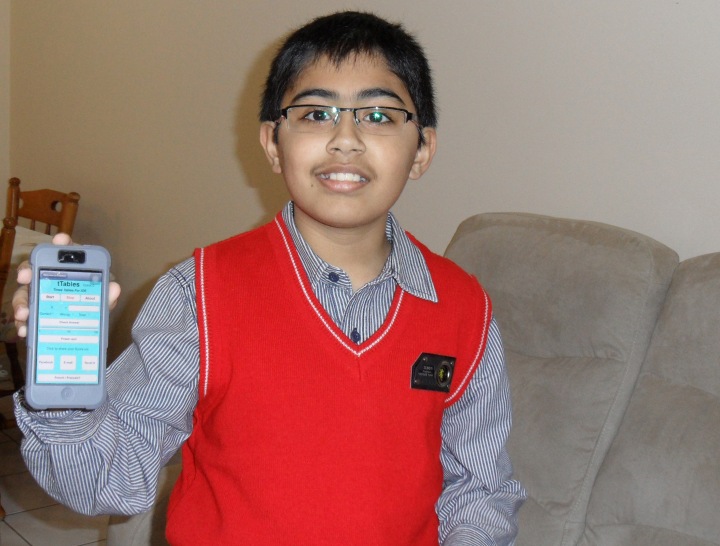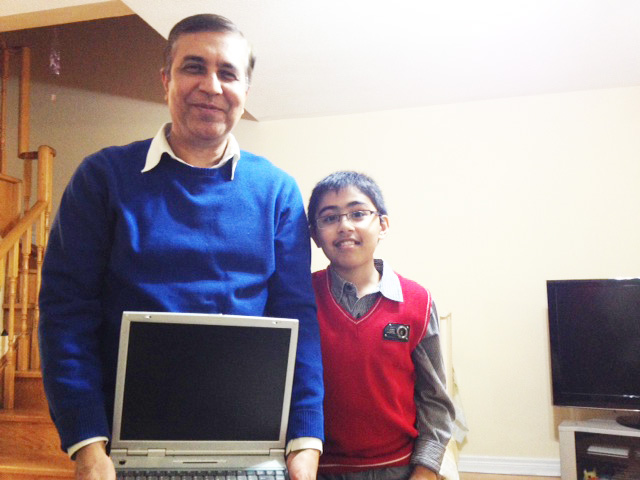
Tanmay Bakshi, 10, has successfully developed an app for Apple. His aptitude for computing and coding has made him a celebrity in Canada and abroad.
Photo by Radhika Panjwani
I am not usually intimidated when interviewing ten year olds, but while chatting with a pint-sized prodigy whose app was accepted by Apple recently, I was momentarily speechless.
The reason probably had more to do with the fact the kid was clearly a genius, whereas, I have had a long-standing feud with numbers, integers and what have you.
Dressed in gray buttoned-down shirt and red sweater vest, a bespectacled Tanmay Bakshi, looked like any other elementary school student, until he started to speak. Not only could he hold on his own, his passion and love for coding lit up his entire face.
Tanmay’s app —tTables —helps children learn times tables. The premise of the free app is quite simple. As you answer multiplication questions, you will either be rewarded with the sound of applause at a correct answer or the ominous sound of buzzing bees when the answer is incorrect.
The cool fact is Tanmay tweaked and perfected his app while in Grade 4 after a chat with his teacher Vikram Ignatius. Turns out, that conversation was an eye-opener because an animated Tanmay, couldn’t wait for the dismissal bell at school to ring. He simply wanted to get home and start the process.
A couple of rejections later, last year, the family received news Apple was finally satisfied and had accepted Tanmay’s creation. The entire process of development took the then nine-year-old a little under two months.
“He has been breaking computers since kindergarten,” said Puneet Bakshi, Tanmay’s dad, a computer programmer himself. “I initiated his learning, but when he felt joy, he carried it on.”
Sitting on the knees of his father even before he could learn to walk or talk, Tanmay learned the basics. His curiosity and love for computers was so great that by Grade 3, he had mastered C, Visual Basic, Python, FoxPro, C, SQL, XCode and Apple-specific languages.
Today, he has lost count of the number of languages he’s skilled at. There’s simply too many. When his fingers fly over the keyboard of his Mac pro, his eyes decipher the meanings of algorithms easily.
The Grade 5 student at Great Lakes Elementary School, is adept at navigating the virtual world of coding, just as easily as an adult that has spend years studying it.
“His power of concentration can be absolute when he’s on the computer, yet he can multitask just as easily,” said Sumita Bakshi, Tanmay’s mother. “Some days, he will be watching a movie or a show, laughing at the punch lines and simultaneously coding on the laptop in front of him.”
So far, tTables has had 6,000 downloads. Not to rest on his previous laurels, Tanmay, the young entrepreneur, has followed his first masterpiece with an encore. His tTables+ is a bilingual app available in both English and French.
Every moment he can spend exploring, decoding and unraveling the world of operating systems and applications is a happy one. The only minor annoyances in the way are stuff like homework, dinner, sleep and probably explaining his work to adults who have no clue.
The Bakshis moved to Canada via England in 2004. Like most immigrant parents, they arrived with few bags of luggage and a whole lot of dreams.

!0-year-old Tanmay seen here with his dad and teacher Puneet Bakshi. Puneet proudly shows of the laptop that Tanmay broke when he was a mere toddler.
Sumita and Puneet work extremely hard to create opportunities for their two children.
After the word of his app got out, more than three dozen media outlets—in Canada and abroad— clamored to interview Tanmay. He’s somewhat a minor celebrity. Tanmay basks in the love of his mom, dad and big sister Tanvi, 19, who’s an inspiration to her brother and vice-versa.
“When I grow up, I want to work with computers,” says Tanmay without hesitation. “What are my hobbies? Computers. What do I speak with my classmates about? Computers. If there was one thing I could do all the time? Coding.”





You must be logged in to post a comment.